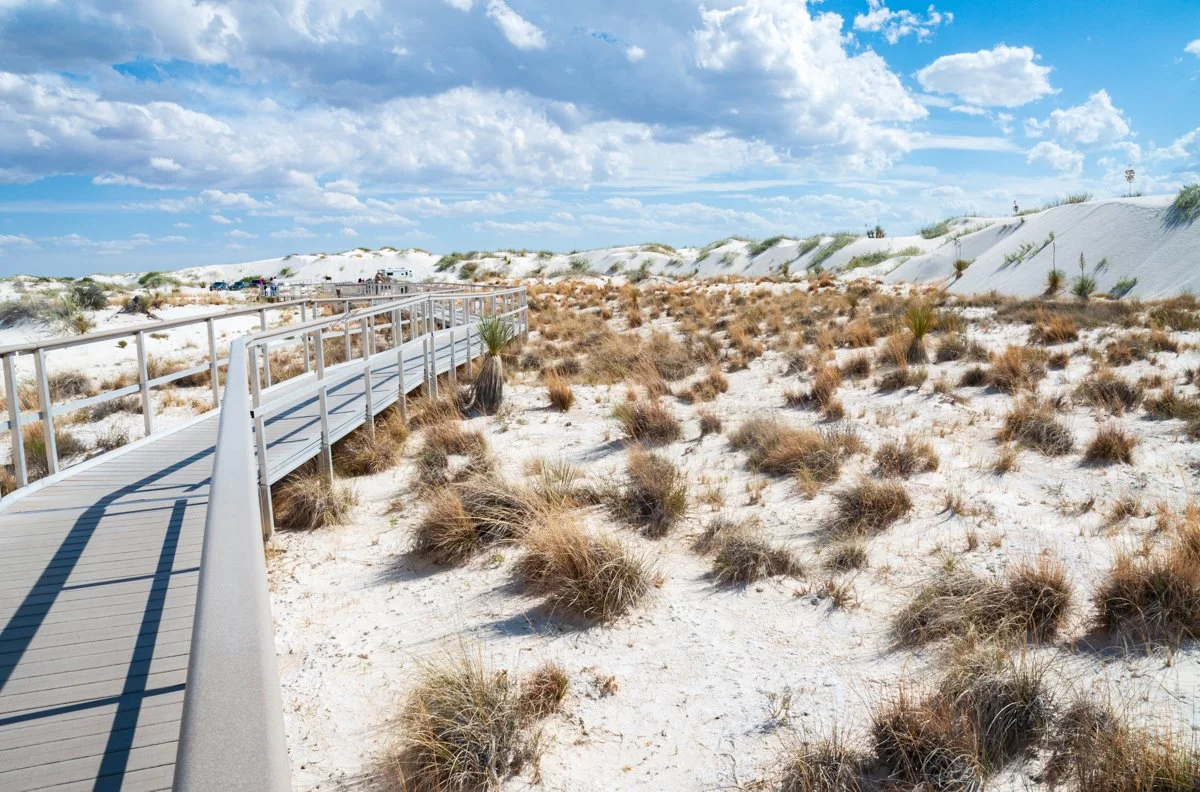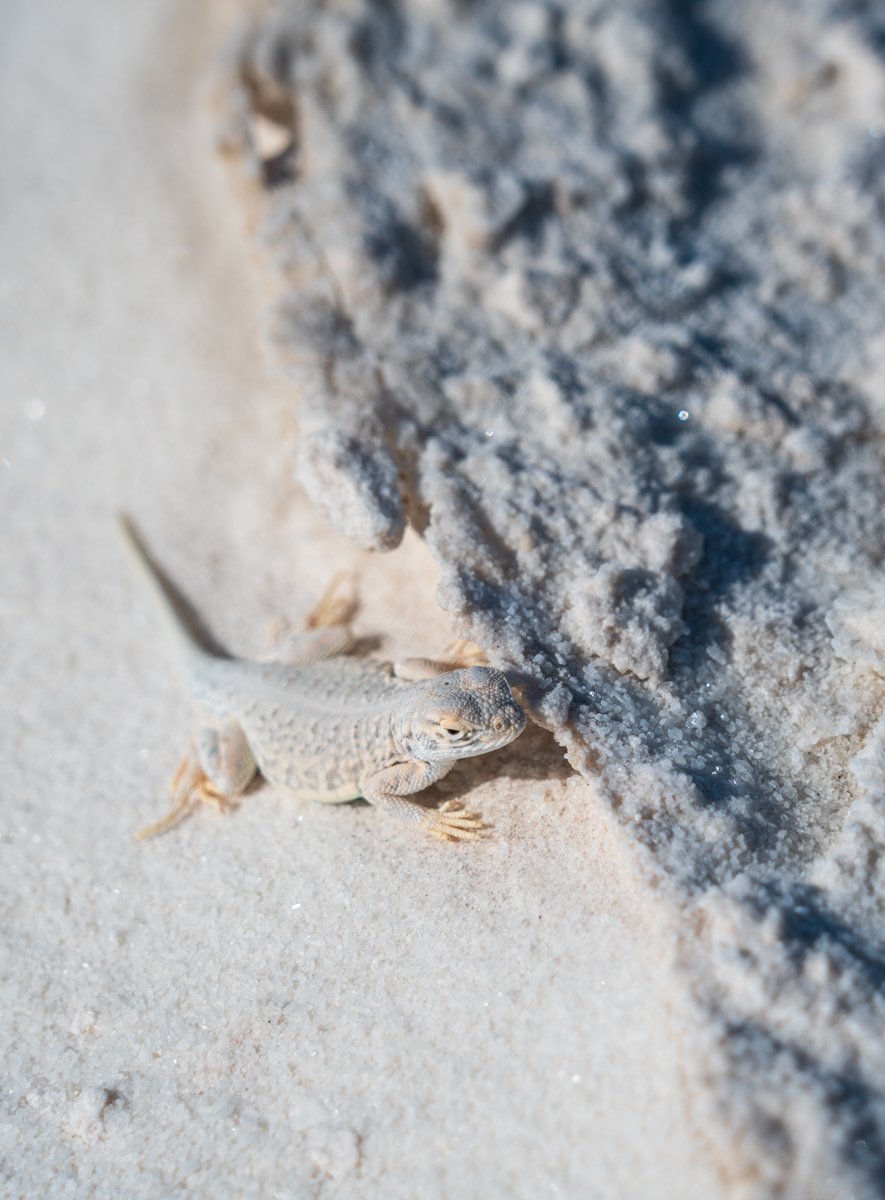White Sands National Park (New Mexico)
White Sands National Park, a striking natural wonder nestled in the heart of the Tularosa Basin in southern New Mexico, is a dazzling expanse of glistening white gypsum sand dunes. This captivating park, renowned for its otherworldly beauty and unique geological features, offers visitors an unforgettable journey into a surreal landscape that enchants and inspires.
Established as a national park in 2019, White Sands National Park spans over 145,000 acres, encompassing the world's largest gypsum dune field. The park's ever-shifting dunes, which are constantly sculpted by the wind, create a mesmerizing tableau of pristine white landscapes that stretch as far as the eye can see.
White Sands National Park is home to an impressive variety of plant and animal life, which has adapted to thrive in the park's challenging environment. Iconic species such as the bleached earless lizard, the Apache pocket mouse, and the uniquely adapted oryx inhabit the park's gypsum dunes, while the resilient flora, including soaptree yucca and cottonwood trees, adds to the park's distinctive charm.
Visitors to White Sands National Park can partake in a wide range of recreational activities that showcase the park's stunning beauty and unique geology. The park offers miles of trails for hiking and nature walks, allowing guests to explore the ever-changing dunes and catch a glimpse of the park's captivating wildlife. Sledding down the dunes is a popular activity, offering a thrilling and fun-filled experience for visitors of all ages. Other popular activities include ranger-led programs, stargazing, and learning about the park's rich cultural history and fascinating geology through exhibits and interpretive displays.
The nearby communities of Alamogordo and Las Cruces serve as gateways to White Sands National Park, offering a variety of accommodations, dining options, and local attractions. These vibrant desert towns ensure that every visitor can experience the park's otherworldly beauty and unique geological features in comfort and style.
MUST SEE SITES
White Sands Dunes: This iconic site located in the heart of White Sands National Park offers visitors a chance to witness the beauty and uniqueness of the park's natural wonder. The dunes are made of gypsum sand that has been blown into beautiful patterns by the wind, and visitors can hike along the trails and enjoy the stunning views of the surrounding landscapes.
Interdune Boardwalk: This unique boardwalk located in the middle of White Sands National Park offers visitors a chance to explore the fascinating ecosystem that exists between the park's sand dunes. The boardwalk features interpretive signs and exhibits that educate visitors about the park's unique flora and fauna.
Backcountry Camping: This secluded area located in the northern part of White Sands National Park offers visitors a chance to experience the park's wilderness up close. Visitors can camp in designated areas and enjoy the stunning views of the park's rugged landscapes and unique wildlife.
Playa Trail: This scenic trail located in the southern part of White Sands National Park offers visitors a chance to explore the park's fascinating geological history. The trail leads to a dry lakebed that forms during the rainy season and is a unique feature of the park's ecosystem. Visitors can hike along the trail and enjoy the stunning views of the surrounding wilderness. With its hidden treasures and unique features, the Playa Trail is a must-see for any visitor to White Sands National Park who wants to experience the park's natural beauty and wonder.
Sunset Stroll: This ranger-led program offers visitors the opportunity to experience the stunning sunset over the white sand dunes, as well as learn about the unique geology and ecology of the area.
GETTING THERE
The most common way to arrive at White Sands National Park is by car. The park is located in southern New Mexico, and can be accessed via several highways. From El Paso, Texas, you can take Interstate 10 to the park's entrance.
If you prefer to travel by air, the closest airport to White Sands National Park is the El Paso International Airport, which is located about an hour's drive from the park. This airport offers flights from several cities, including Los Angeles, Dallas, and Phoenix.
Once you arrive at White Sands National Park, the best way to get around is by car or by foot. The park is home to a scenic drive and several hiking trails, including the Alkali Flat Trail and the Interdune Boardwalk Trail. There are also several picnic areas available for day use, and backcountry camping is permitted with a permit.
GATEWAY COMMUNITIES
The city of Alamogordo serves as the primary gateway community to White Sands National Park, offering various accommodations, dining options, souvenir shops, and outdoor recreation equipment rentals.
ACCOMMODATIONS
Visitors can find various lodging options in the surrounding community, including hotels, motels, and vacation rentals. Additionally, there is a backcountry camping area available within the park, providing a unique camping experience among the dunes.
CAMPGROUNDS
White Sands National Park offers a backcountry camping area with 10 designated sites, accessible only by hiking. These sites provide a unique camping experience among the gypsum sand dunes, with no amenities such as restrooms or drinking water. Campers must obtain a backcountry camping permit from the visitor center on a first-come, first-served basis.
WEATHER/CLIMATE
White Sands National Park has a desert climate, with hot summers and cool winters. Average summer temperatures can range from the 80s to 100s Fahrenheit, while winter temperatures can dip below freezing. Visitors should be prepared for potential rain and rapidly changing weather conditions, as well as extreme temperature fluctuations between day and night.
RECREATION OPPORTUNITIES
Numerous recreational opportunities await visitors, including hiking, sand sledding, and wildlife viewing. The park offers miles of hiking trails, providing opportunities to explore the unique gypsum sand dunes and observe the stunning desert landscapes. Popular hikes include the Dune Life Nature Trail, the Playa Trail, and the Alkali Flat Trail. Sand sledding is a popular activity, with plastic sleds available for purchase or rent at the visitor center. Wildlife viewing is also popular, with a variety of species such as the bleached earless lizard, kit fox, and desert pocket mouse inhabiting the park.
VISITOR CENTER
White Sands National Park has a visitor center that provides information about the park's history, ecology, wildlife, and recreational opportunities. Rangers are available to offer guidance and answer questions. The visitor center is open daily, with some exceptions for major holidays or seasonal closures.
THINGS TO KNOW
Entrance Fee: $25 per vehicle (7-day pass), $20 per motorcycle (7-day pass), $15 per person (7-day pass), or $45 for an annual park pass.
Pet Policy: Pets are allowed in the park but must be leashed and under control at all times. Pets are not allowed in park buildings or on designated ranger-led programs.
Hours of operation: The park is open daily, year-round, with some exceptions for holidays and special events. Visitor center hours and specific facility hours can be found on the park's website.
Website: https://www.nps.gov/whsa/index.htm
Contact phone number: (575) 479-6124
Address: White Sands National Park, 19955 Highway 70 West, Alamogordo, NM 88310, United States





